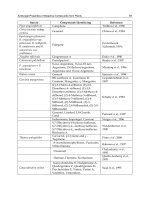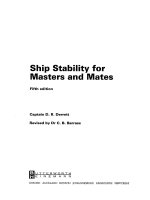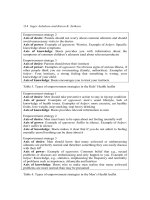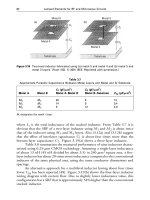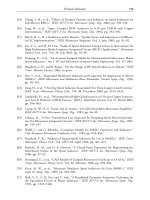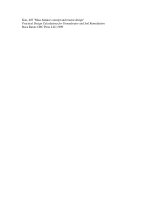Ship Stability for Masters and Mates 5 Episode 6 ppsx
Bạn đang xem bản rút gọn của tài liệu. Xem và tải ngay bản đầy đủ của tài liệu tại đây (754.29 KB, 35 trang )
and are given for each one metre difference between 9 metres and the ship's
actual KG. To ®nd the correction to the GZ, multiply the correction taken from
the table for the angle of heel concerned, by the difference in KGs. To apply the
correction: when the ship's KG is greater than 9 metres the ship is less stable and
the correction must be subtracted, but when the KG is less than 9 metres the ship
is more stable and the correction is to be added.
The derivation of the table is as follows:
In Figure 16.2(a), KG is 9 m, this being the KG for which this set of curves is
plotted, and GZ represents the righting lever, as taken from the curves for this
particular angle of heel.
Consider the case when the KG is greater than 9 m (KG
1
in Figure 16.2(a)).
The righting lever is reduced to G
1
Z
1
. Let G
1
X be perpendicular to GZ. Then
G
1
Z
1
XZ
GZ ÀGX
or
Corrected GZ Tabulated GZ À Correction
Also, in triangle GXG
1
:
GX GG
1
sin y
or
Correction GG
1
sin y
where y
is the angle of heel.
But GG
1
is the difference between 9 m and the ship's actual KG. Therefore, the
corrections shown in the table on the Cross Curves for each one metre
difference of KG are simply the Sines of the angle of heel.
Now consider the case where KG is less than 9 m (KG
2
in Figure 16.2(b)).
The length of the righting lever will be increased to G
2
Z
2
.
Let GY be perpendicular to G
2
Z
2
then
G
2
Z
2
YZ
2
G
2
Y
164 Ship Stability for Masters and Mates
Fig. 16.2(a)
but
YZ
2
GZ
therefore
G
2
Z
2
GZ G
2
Y
or
Corrected GZ Tabulated GZ Correction
Also, in triangle GG
2
Y:
G
2
Y GG
2
sin y
or
Correction GG
2
sin heel
It will be seen that this is similar to the previous result except that in this case
the correction is to be added to the tabulated GZ.
Example 2
Using the Stability Cross Curves for M.V. `Tanker', ®nd the GZs at 15-degree
intervals between 0 degrees and 90 degrees when the displacement is 38 000
tonnes and the KG is 8.5 metres.
Stability and hydrostatic curves 165
Fig. 16.2(b)
Heel Tabulated GZ Correction Correct GZ
(KG 9 m) (GG
1
sin y
) (KG 8.5 m)
0
0 0.5 Â0 000 0
15
0.81 0.5 Â0.259 0X129 0.81 0.13 0X94
30
1.90 0.5 Â0.5 0X250 1.90 0.25 2X15
45
2.24 0.5 Â0.707 0X353 2.24 0.35 2X59
60
1.70 0.5 Â0.866 0X433 1.70 0.43 2X13
75
0.68 0.5 Â0.966 0X483 0.68 0.48 1X16
90
À0.49 0.5 Â1.000 0X500 À0.49 0.50 0X01
Fig. 16.3(a). M.V. `Cargo-Carrier'
KN Cross Curves of Stability
It has already been shown that the Stability Cross Curves for a ship are
constructed by plotting the righting levers for an assumed height of the
centre of gravity above the keel. In some cases the curves are constructed
for an assumed KG of zero. The curves are then referred to as KN curves,
KN being the righting lever measured from the keel. Figure 16.3(a) shows
the KN curves for an imaginary ship called the M.V. `Cargo-Carrier'.
To obtain the righting levers for a particular displacement and KG the
values of KN are ®rst obtained from the curves by inspection at the
displacement concerned. The correct righti ng levers are then obtained by
subtracting from the KN values a correction equal to the product of the KG
and sin Heel.
In Figure 16.3(b), let KN represent the ordinate obtained from the curves.
Also, let the ship's centre of gravity be at G so that KG represents the
actual height of the centre of gravity above the keel and GZ represents the
length of the righting lever.
Now
GZ XN
KN À KX
or
GZ KN ÀKG sin y
Thus, the righting lever is found by always subtracting from the KN
ordinate a correction equal to KG sin heel.
Stability and hydrostatic curves 167
Fig. 16.3(b)
Example 3
Find the righting levers for M.V. `Cargo-Carrier' when the displacement is
40 000 tonnes and the KG is 10 metres.
2. Statical Stability curves
The curve of statical stability for a ship in any particular condition of
loading is obtained by plotting the righting levers against angle of heel as
shown in Figures 16.4 and 16.5.
From this type of graph a considerable amount of stability information
may be found by inspection:
The range of stability. This is the range over which the ship has positive
righting levers. In Figure 16.4 the range is from 0 degrees to 86 degrees.
The angle of vanishing stability . This is the angle of heel at which the
righting lever returns to zero, or is the angle of heel at which the sign of the
168 Ship Stability for Masters and Mates
Heel y KN sin y KG sin y GZ KN ÀKG sin y
5
0.90 0.087 0.87 0.03
10
1.92 0.174 1.74 0.18
15
3.11 0.259 2.59 0.52
20
4.25 0.342 3.42 0.83
30
6.30 0.500 5.00 1.30
45
8.44 0.707 7.07 1.37
60
9.39 0.866 8.66 0.73
75
9.29 0.966 9.66 À 0.37
90
8.50 1.000 10.00 À 1.50
Fig. 16.4. Curve for a ship with positive initial metacentric height.
righting levers changes from positive to negative. The angle of vanishing
stability in Figure 16.4 is 86 degrees.
The maximum GZ is obtained by drawing a tangent to the highest point
in the curve. In Figure 16.4, AB is the tangent and this indicates a maximum
GZ of 0.63 metres. If a perpendicular is dropped from the point of
tangency, it cuts the heel scale at the angle of heel at which the maximum
GZ occurs. In the present case the maximum GZ occurs at 42 degrees heel.
The initial metacentric height (GM) is found by drawing a tangent to the
curve through the origin (OX in Figure 16.4), and then erecting a
perpendicular through an angle of heel of 57.3 degrees. Let the two lines
intersect at Y. Then the height of the intersection above the base (YZ),
when measured on the GZ scale, will give the initial metacentric height. In
the present example the GM is 0.54 metres.
Figure 16.5 shows the stability curve for a ship having a negative initial
metacentric height. At angles of heel of less than 18 degrees the righting
levers are negative, whilst at angles of heel between 18 degrees and 90
degrees the levers are positive. The angle of loll in this case is 18 degrees,
the range of stability is 18 degrees to 90 degrees, and the angle of
vanishing stability is 90 degrees. (For an explanation of angle of loll see
Chapter 6, page 48.) Note how the Àve GM is plotted at 57.3
.
Example 1
Using the stability cross curves for M.V. `Tanker', plot the curve of statical
stability when the displacement is 33 500 tonnes and KG 9.3 metres. From
the curve ®nd the following:
(a) The range of stability.
(b) The angle of vanishing stability.
(c) The maximum righting lever and the angle of heel at which it occurs.
Stability and hydrostatic curves 169
Fig. 16.5. Curve for a ship with negative initial metacentric height.
(d) The initial metacentric height.
(e) The moment of statical stability at 25 degrees heel .
For the graph see Figure 16.6(a),
Answers from the curve:
(a) Range of Stability 0 degrees to 81 degrees.
(b) Angle of vanishing stability 81 degrees.
(c) Maximum GZ 2.35 m occurring at 43 degrees heel.
(d) GM is 2.30 m.
(e) GZ at 25 degrees heel 1X64 m.
Moment of statical stability W ÂGZ
33 500 Â 1X64
54 940 tonnes m
170 Ship Stability for Masters and Mates
Heel Tabulated GZ Correction to GZ Required GZ
(KG 9 m) (GG
1
sin heel) (KG 9.3 m)
0
00Â0 0 0
15
0.90 0.3 Â0.259 0X08 0X90 À 0X08 0X82
30
2.15 0.3 Â0.500 0X15 2X15 À 0X15 2X00
45
2.55 0.3 Â0.707 0X21 2X55 À 0X21 2X34
60
1.91 0.3 Â0.866 0X26 1X91 À 0X26 1X65
75
0.80 0.3 Â0.966 0X29 0X80 À 0X29 0X51
90
À 0.50 0.3 Â1.000 0X30 À 0X50 À0X30 À0X80
Fig. 16.6(a)
Example 2
Construct the curve of statical stability for the M.V. `Cargo-Carrier' when the
displacement is 35 000 tonnes and KG is 9 metres. From the curve you have
constructed ®nd the following:
(a) The range of stability,
(b) The angle of vanishing stability,
(c) The maximum righting lever and the angle of the heel at which it occurs,
and
(d) The approximate initial metacentric height.
From the Stability Cross Curves:
Answers from the curve:
(a) Range of stability 0
to 83
3
4
,
(b) Angle of vanishing stability 83
3
4
,
(c) Maximum GZ 2.39 m occurring at 45
heel,
(d) Approximate GM 1.4 m.
Stability and hydrostatic curves 171
Heel y KN sin y KG sin y GZ KN ÀKG sin y
5
0.9 0.087 0.783 0.12
10
2.0 0.174 1.566 0.43
15
3.2 0.259 2.331 0.87
20
4.4 0.342 3.078 1.32
30
6.5 0.500 4.500 2.00
45
8.75 0.707 6.363 2.39
60
9.7 0.866 7.794 1.91
75
9.4 0.966 8.694 0.71
90
8.4 1.000 9.000 À 0.60
Fig. 16.6(b). This is the curve of statical stability
3. Hydrostatic curves
Hydrostatic information is usually supplied to the ship's of®cer in the form
of a table or a graph. Figure 16.7 shows the hydrostatic curves for the
imaginary ship M.V. `Tanker'. The various items of hydrostatic information
are plotted against draft.
When information is required for a speci®c draft, ®rst locate the draft on
the scale on the left-hand margin of the ®gure. Then draw a horizontal line
through the draft to cut all of the curves on the ®gure. Next draw a
perpendicular through the intersections of this line with each of the curves
in turn and read off the information from the appropriate scale.
Example 1
Using the hydrostatic curves for M.V. `Tanker', take off all of the information
possible for the ship when the mean draft is 7.6 metres.
(1) TPC 39.3 tonnes
(2) MCT 1 cm 475 tonnes-metres
(3) Displacement 33 000 tonnes
(4) Longitudinal centre of ¯otation is 2.2 m forward of amidships
(5) Longitudinal centre of buoyancy is 4.0 m forward of amidships.
When information is required for a speci®c displacement, locate the disp lace-
ment on the scale along the top margin of the ®gure and drop a perpendicular
to cut the curve marked `Displacement'. Through the intersection draw a
horizontal line to cut all of the other curves and the draft scale. The various
quantities can then be obtained as before.
Example 2
From the hydrostatic curves take off the information for M.V. `Ta nker' when
the displacement is 37 500 tonnes.
(1) Draft 8.55 m
(2) TPC 40 tonnes
(3) MCT 1 cm 500 tonnes m
(4) Longitudinal centre of ¯otation is 1.2 m forward of amidships.
(5) Longitudinal centre of buoyancy is 3.7 m forward of amidships.
The curves themselves are produced from calculations involving Simpson's
Rules. These involve half-ordinates, areas, moments and moments of inertia for
each water line under consideration.
Using the hydrostatic curves
After the end drafts have been taken it is necessary to interpolate to ®nd
the `mean draft'. This is the draft immediately below the LCF which may be
aft, forward or even at amidships. This draft can be labelled d
H
.
If d
H
is taken as being simply the average of the two end drafts then in
large full-form vessels (supertankers) and ®ne-form vessels (container ships)
an appreciable error in the displacement can occur. (See Fig. 16.8.)
172 Ship Stability for Masters and Mates
Fig. 16.7. M.V. `Tanker'
Let us assume the true mean draft `d
H
' is 6 m. The Navel Architect or mate
on board ship draws a horizontal line parallel to the SLWL at 6 m on the
vertical axis right across all of the hydrostatic curves.
At each intersection with a curve and this 6 m line, he projects
downwards and reads off on the appropriate scale on the `x' axis.
For our hydrostatic curves, at a mean draft of 6 m, for example, we would
obtain the following:
TPC 19X70 t
MCTC 152X5 tm/cm
LCB 0X80 m forward
KM
T
7X46 m
Displace
MT
10 293 t
LCF 0X05 m forward
KML 207X4m
These values can then be used to calculate the new end drafts and transverse
stability, if weights are added to the ship, discharged from the ship or simply
moved longitudinally or transversely within the ship.
LCF and LCB are distances measured from amidships (
e
).
Nowadays these values can be put on a spreadsheet in a computer
package. When the hydrostatic draft d
H
is keyed, the hydrostatic values
appertaining to this draft are then displayed, ready for use.
A set of hydrostatic values has been calculated for a 135 m General
Cargo Ship of about 10 000 tonnes deadweight. These are shown overpage.
From those values a set of hydrostatic curves were drawn. These are shown
in Fig. 16.9.
174 Ship Stability for Masters and Mates
e
e
Draft
Fig. 16.8
e
e
e
e
e
e
e
e
e
Hydrostatic values for Fig. 16.9 (overpage). These are for a 135 m LBP General Cargo Ship
Draft d
H
TPC KB Displace
MT
KM
L
MCTC KM
T
LCF LCB
(see below) tonnes m tonnes m tm/cm m m m
m
9 m 20.64 4.80 16 276 146.5 167.4 7.71 2.10 aft 0.45 aft
8 m 20.36 4.27 14 253 161.8 162.9 7.54 1.20 aft
7 m 20.06 3.74 12 258 181.5 158.1 7.44 0.50 aft 0.45 forward
6 m 19.70 3.21 10 293 207.4 152.5 7.46 0.05 forward 0.80 forward
5 m 19.27 2.68 8361 243.2 145.9 7.70 0.42 forward 1.05 forward
4 m 18.76 2.15 6486 296.0 138.3 8.28 0.70 forward 1.25 forward
3 m 18.12 1.61 4674 382.3 129.1 9.56 0.83 forward 1.30 forward
2
1
2
m 17.69 1.35 3785 449.0 123.0 10.75 0.85 forward 1.30 forward
Fig. 16.9. Hydrostatic curves: based on values tabulated on previous page. These are for a 135 m LBP General Cargo Ship
e
e
e
e
Stability and hydrostatic curves 177
EXERCISE 16
1 Plot the curve of stability for M.V. `Tanker' when the displacement is
34 500 tonnes and KG 9 m. From this curve ®nd the approximate GM,
the range of stability, the maximum GZ and the angle of heel at which it
occurs.
2 Plot the curve of statical stability for M.V. `Tanker' when the displacement
is 23 400 tonnes and KG 9.4 m. From this curve ®nd the approximate
GM, the maximum moment of statical stability and the angle of heel at
which it occurs . Find also the range of stability.
3 The displacement of M.V. `Tanker' is 24 700 tonnes and KG 10 m.
Construct a curve of statical stability and state what information may be
derived from it. Find also the moments of statical stability at 10 degrees
and 40 degrees heel.
4 Using the cross curves of stability for M.V. `Tanker':
(a) Draw a curve of statical stability when the displacement is 35 000
tonnes, KG 9.2 metres, and KM 11.2 m, and
(b) From this curve determine the moment of statical stability at 10
degrees heel and state what other information may be obtained from
the curve.
5 Plot the stability curve for M.V. `Tanker' when the displacement is 46 800
tonnes and KG 8.5 metres. From this curve ®nd the approximate GM,
the range of stability, the maximum GZ and the angle of heel at which it
occurs.
6 From the hy drostatic curves for M.V. `Tanker' ®nd the mean draft when
entering a dock where the density of the water is 1009 kg per cu. m, if the
mean draft in salt water is 6.5 m.
7 Find the mean draft of M.V. `Tanker' in dock water of density 1009 kg per
cu. m when the displacement is 35 400 tonnes.
8 M.V. `Tanker' is 200 m long and is ¯oating at the maximum permissible
draft aft. There is one more parcel of heavy cargo to load on deck to put
her down to her marks at the load displacement of 51 300 tonnes. Find the
position, relative to amidships, to load the parcel so as to maintain the
maximum possible trim by the stern.
9 Using the hydrostatic curves for M.V. `Tanker' ®nd the displacement,
MCT 1 cm and the TPC, when the ship is ¯oating in salt water at a mean
draft of 9 metres.
Also ®nd the new mean draft if she now enters a dock where the
density of the water is 1010 kg per cu. m.
10 M.V. `Tanker' is 200 m long and has a light displacement of 16 000 tonnes.
She has on board 100 tonnes of cargo, 300 tonnes of bunkers, and 100
tonnes of fresh water and stores. The ship is trimmed 1.5 m by the stern.
Find the new drafts if the 100 tonnes of cargo already on board is now
shifted 50 m forward.
11 Construct the curve of statical stability for M.V. `Cargo-Carrier' when
178 Ship Stability for Masters and Mates
the displ acement is 35 000 tonnes and KG is 8 metres. From this curve
®nd
(a) the range of stability,
(b) the angle of vanishing stability and,
(c) the maximum GZ and the heel at which it occurs.
12 Construct the curve of statical stability for M.V. `Cargo-Carrier' when the
displacement is 28 000 tonnes and the KG is 10 metres. From the curve
®nd
(a) the range of stability,
(b) the angle of vanishing stability, and
(c) the maximum GZ and the heel at which it occurs.
13 A vessel is loaded up ready for departure. KM is 11.9 m. KG is 9.52 m
with a displacement of 20 550 tonnes. From the ship's Cross Curves of
Stability, the GZ ordinates for a displacement of 20 550 tonnes and a
VCG of 8 m above base are as follows
Angle of heel y 0 153045607590
GZ ordinate (m) 0 1.10 2.22 2.60 2.21 1.25 0.36
Using this information, construct the ship's Statical Stability curve for this
condition of loading and determine the following:
(a) Maximum righting lever GZ.
(b) Angle of heel at which this maximum GZ occurs.
(c) Angle of heel at which the deck edge just becomes immersed.
(d) Range of stability.
14 Using the table of KN ordinates below calculate the righting levers for a
ship when her displacement is 40 000 tonnes and her actual KG is 10 m.
Draw the resultin g Statical Stability curve and from it determine:
(a) Maximum GZ value.
(b) Approximate GM value.
(c) Righting moment at the angle of heel of 25
.
(d) Range of Stabil ity.
Angle of heel y 0 5 10 15 20 30 45 60
KN ordinates (m) 0 0.90 1.92 3.11 4.25 6.30 8.44 9.39
Angle of heel y 75 90
KN ordinates (m) 9.29 8.50
Chapter 17
Increase in draft due to
list
1. Box-shaped vessels
The draft of a vessel is the depth of the lowest point below the waterline.
When a box-shaped vessel is ¯oating upright on an even keel as in Figure
17.1(a) the draft is the same to port as to starboard. Let the draft be `d' and
let the vessel's beam be `b'.
Now consider the same vessel when listed y degrees as shown in Figure
17.1(b). The depth of the lowest po int or draft is now increased to `D' (XY).
Fig. 17.1(a)
Fig. 17.1(b)
In triangle OXA:
OA
1
2
b and angle AXO 90
; AX
1
2
b sin y
In triangle ABY:
AB d and angle AYB 90
; AY d cos y
D XY
AX AY
D
1
2
b sin y d cos y
or
New draft
1
2
beam sin list Old draft cos list
Note. It will usually be found convenient to calculate the draft when listed
by using the triangles AOX and ABY.
Example 1
A box-shaped ship with 12 m beam is ¯oating upright at a draft of 6.7 m. Find
the increase in draft if the vessel is now listed 18 degrees.
In triangle OAX:
Angle AOX 18
Therefore use course 18
OA (Dist.) 6X0m
AX (Dep.) 1X85 m
In triangle ABY:
Angle BAY 18
Therefore use course 18
AB (Dist.) 6X7m
AY (D. Lat.) 6X37 m
180 Ship Stability for Masters and Mates
Fig. 17.2(a)
AX 1X85 m
AY 6X37 m
New draft 8X22 m
Old draft 6X70 m
1X52 m
Ans.
Increase 1X52 m
Example 2
Using the dimensions of the ship given in example 1, proceed to calculate the
increase in draft at 3
intervals from 0
to 18
. Plot a graph of draft increase
G y.
1
2
beam sin y
1
2
 12  siny 6 sin y I
Old draft cos y 6X7 cos y II
Increase in draft (I) (II) À Old draft in metres.
The above results clearly show the increase in draft or loss of underkeel
clearance when a vessel lists.
Ships in the late 1990s are being designed with shorter lengths and wider
breadths mainly to reduce ®rst cost and hogging/sagging characteristics.
These wider ships are creating problems sometimes when initial underkeel
clearance is only 10 per cent of the ship's static draft. It only requires a small
angle of list for them to go aground in way of the bilge strakes.
One ship, for example, is the supertanker Esso Japan. She has an LBP of 350 m
and a width of 70 m at amidships. Consequently extra care is required should
possibilities of list occur.
Figure 17.2(b) (on page 182) shows the requested graph of draft increase Gy.
2. Vessels having a rise of ¯oor
Example 3
A ship has 20 m beam at the waterline and is ¯oating upright at 6 m draft. If the
rise of ¯oor is 0.25 m, calculate the new draft if the ship is now listed 15 degrees
(See Figure 17.3)
Increase in draft due to list 181
Angle of list 6 sin y 6.7 cos y Old draft Increase in draft (m)
0
0 6.70 6.70 0
3
0.31 6.69 6.70 0.30
6
0.63 6.66 6.70 0.59
9
0.94 6.62 6.70 0.86
12
1.25 6.55 6.70 1.10
15
1.55 6.47 6.70 1.32
18
1.85 6.37 6.70 1.52
182 Ship Stability for Masters and Mates
Fig. 17.2(b). Draft increase G angle of list y
Fig. 17.3
In triangle OAX:
Angle O 15
Therefore use course 15
AO (Dist.) 10 m
AX (Dep.) 2X59 m
In triangle ABY:
Angle A 15
Therefore use course 15
AB (Dist.) AC ÀBC
Old draft À Rise of floor
6mÀ 0X25 m
AB (Dist.) 5X75 m
AY (D. Lat.) 5X55 m
AX 2X59 m
AY 5X55 m
XY 8X14 m
Ans.
New draft 8X14 metres
If the formula is to be used to ®nd the new draft it must now be amended to
allow for the rise of ¯oor as follows:
New draft
1
2
beam sin list (Old draft À Risecos list.
Note. In practise, the shipbuilder's naval architect usually calculates the increase
in draft for the ship at various angles of list and suppliers the information to the
ship's of®cer by means of a table on the plans of the ship.
The rise of ¯oor, similar to tumblehome on merchant ships, has almost
become obsolute on merchant ships of today.
Increase in draft due to list 183
Exercise 17
1 A box-shaped vessel with 10 m beam, and 7.5 m deep, ¯oats upright at a
draft of 3 m. Find the increase of draft when listed 15 degrees to starboard.
2 A ship 90 m long, 15 m beam at the waterline, is ¯oating upright at a draft
of 6m. Find the increase of draft when the ship is listed 10 degrees,
allowing 0.15 m rise of ¯oor.
3 A box-shaped vessel 60 m Â6mÂ4 m draft is ¯oating upright. Find the
increase in the draft if the vessel is now listed 15 degrees to port.
4 A box-shaped vessel increases her draft by 0.61 m when listed 12 deg rees
to starboard. Find the vessel's beam if the draft, when upright, was 5.5 m.
5 A box-shaped vessel with 10 m beam is listed 10 degrees to starboard and
the maximum draft is 5 m. A weight already on board is shifted
transversely across the deck, causing the vessel to list to port. If the ®nal
list is 5 degrees to port, ®nd the new draft.
Chapter 18
Water pressure
The water pressure at any depth is due to the weight of water above the
point in question and increases uniformly with depth below the surface.
From this it can be seen that the pressure at any depth will vary with the
depth below the surface and the density of the water.
Pressure at any depth
Consider an area of 1 sq m at the water level as shown by ABCD in Figure
18.1. The water pressure on this area is zero as there is no water above it.
Now consider the area EFGH which is submerged to a depth of 1 m
below the surface. There is 1 cu. m of water above it. Let the density of the
water be `w' tonnes per cu. m. Then the pressure on this area is `w' tonnes
per sq m, and the total pressure or thrust on an area of `A' sq m whose
centre of gravity is 1 m below the surface, will be wA tonnes.
Next consider the area IJKL whose centre of gravity is 2 m below the
surface. The pressure is now due to 2 cu. m of water and will be 2 w tonnes
per sq m. Also, the total pressure or thrust on any area whose centre of
gravity is 2 m below the surface, is 2 wA tonnes.
Similarly, the pressure on the area MNOP will be 3 w tonnes per sq
metre, and the total pressure or thrust on any area whose centre of gravity
is 3 m below the surface will be 3 wA tonnes.
The following formulae may now be deduced:
Total pressure or thrust w ÂA Âh tonnes
where
h the depth of the centre of gravity below the surface
w the density of the water in tonnes/m
3
, and
A the area in sq m.
Example 1
Find the water pressure and the total thrust on the ¯at plate keel of a ship which
is ¯oating on an even keel at 4 metres mean draft in water of densi ty 1.024 t/
m
3
per cu. m. The keel plate is 35 m long and 1.5 m wide.
Pressure 4 Â1X024 4X1 tonnes/m
2
Total Thrust w ÂA Âh
1X024 Â35 Â1X5 Â4
Total Thrust 215X04 tonnes
Example 2
A lock gate which is 15 m wide has salt water on one side to a depth of 8 m and
fresh water on the other side to a depth of 9 m. Find the resultant thrust on the
lock gate and state on which side of the gate it acts.
Water pressure 185
Fig. 18.1
Fig. 18.2
Let P
1
thrust on the SW side, and P
2
thrust on the FW side
; P
1
Pressure on the SW side
P
1
r
SW
 A Âh
1
1X025 Â15 Â8 Â
8
2
P
1
492 tonnes
; P
2
Pressure on the FW side
P
2
r
FW
 A  h
2
1X000 Â15 Â9 Â
9
2
P
2
607X5 tonnes
Resultant thrust P
2
À P
1
607X5 À492
Ans.
Resultant thrust 115.5 tonnes on the FW side
Example 3
Find the pressure and total thrust on two deep tank lids, each 4 m Â2.5 m,
resting on coamings 30 cm high, when the tank is ®lled with salt water to a
head of 9.3 m above the crown of the tank.
Pressure at A Pressure at B (see Figure 18.3)
w ÂA Âh
1X025 Â1X0m
2
 9X0
Pressure on lids 9X225 tonnes per sq m
Total thrust 2 Âthrust on one lid
2 Â(P ÂA)
2 Â9X225 Â4 Â2X5 tonnes
Total thrust 184X5 tonnes
Ans.
Pressure 9X225 tonnes per sq m. Total thrust 184X5 tonnes.
186 Ship Stability for Masters and Mates
Fig. 18.3
Water pressure 187
Exercise 18
1 A sealed box is made of metal and is capable of withstanding a pressure of
15.54 kN per sq m. Find to what depth the box may be submerged in salt
water before it collapses.
2 Find the water pressure, in kilo-ne wtons per sq m, on the keel of a ship
which is ¯oating upright on an even keel in salt water at a draft of 6
metres.
3 A ship is ¯oating on an even keel in salt water at a draft of 7 metres. She
has a ¯at plate keel which is 100 m long and 2 m wide. Find the water
pressure and the total thrust on the keel due to the water.
4 Find the water pressure and thrust on a ¯at plate keel 6 m long and 1.5 m
wide when the ship is ¯oating on an even keel at 6 m draft in salt water.
5 Find the water pressure and thrust on the inner bottom plating of a double
bottom tank (10 m Â10 m) when the tank is ®lled with fresh water to a
head of 9 m above the crown of the tank.
6 A deep tank has two lids, each 4 m Â3 m, resting on coamings which are
30 cm high. Find the water pressure on each of the two lids and the total
thrust on both lids when the tank is ®lled with salt water to a head of
6.3 m above the crown of the tank.
7 A rectangular plate 2 m Â1 m is held vertically in fresh water with the 2 m
edge on the waterline. Find the thrust on one side of the plate.
8 A lock gate 12 m wide has water of density 1010 kg per cu. m to a depth
of 10 m on one side and water of density 1015 kg per cu. m to a depth of
6 m on the other side. Find the resultant thrust on the lock gate and state
on which side it acts.
9 A lock gate is 20 m wide and has water of dens ity 1016 kg per cu. m on
one side to a depth of 10 m and salt water on the other side to a depth of
7.5 m. Find the resultant thrust and state on which side of the gate it will
act.
10 Find the total water pressure acting on a box-shaped barge keel plating
which is 60 m long 10 m wide, and is ¯oating upright in salt water on an
even keel at 5 m draft.
11 A box-shaped barge has a rectangular collision bulkhead 10 m wide and
6 m deep. Find the total water pressure on this bulkhead if the forepeak is
¯ooded to a depth of 5 m with salt water.
Chapter 19
Combined list and trim
When a problem involves a change of both list and trim, the two parts must
be treated quite separately. It is usually more convenient to tackle the trim
part of the problem ®rst and then the list, but no hard and fast rule can be
made on this point.
Example 1
A ship of 6000 tonnes displacement has KM 7m, KG 6.4 m, and MCT
1cm 120 tonnes m. The ship is listed 5 degrees to starboard and trimmed
0.15 m by the head. The ship is to be brought upright and trimmed 0.3 m by
the stern by transferring oil from No. 2 double bottom tank to No. 5 double
bottom tank. Both tanks are divided at the centre line and their centres of
gravity are 6 m out from the centre line. No. 2 holds 200 tonnes of oil on each
side and is full. No. 5 holds 120 tonnes on each side and is empty. The centre of
gravity of No. 2 is 23.5 m forward of amidships and No. 5 is 21.5 m aft of
amidships. Find what transfer of oil must take place and give the ®nal
distribution of the oil. (Negle ct the effect of free surface on the GM.)
Assume that LCF is at amidships.
(a) To bring the ship to the required trim
Present trim 0X15 m by the head J
Required trim
0X30 m by the stern I
Change of trim 0X45 m by the stern I
45 cm by the stern I
Trim moment Change of trim ÂMCT 1 cm
45 Â120
Trim moment 5400 tonnes m by the stern I
Let `w' tonnes of oil be transferred aft to produce the required trim.
![ship stability for masters and mates [electronic resource]](https://media.store123doc.com/images/document/14/y/bj/medium_bjc1401370968.jpg)

